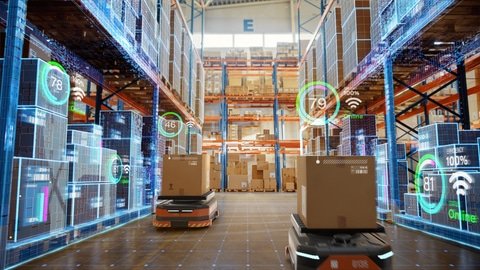End Woes that Have Plagued Management for Millennia
Distribution and fulfillment centers have faced the same problems for millennia. Today’s warehouse AI can solve a lot of those problems.
Poor integration of automation is a relatively new concern. But bad layouts, slow and inaccurate order picking, low productivity, inefficient space utilization and unpreparedness for peak seasons probably bedeviled warehousing in ancient Rome. Today’s era is only increasing those pressures. Constant disruptions include eCommerce growth, labor shortages and shifting consumer expectations.
With smarter systems in place, warehouse teams can pick, pack and ship items more efficiently and effectively than ever before. Better warehouse efficiency boosts every metric – from managing inventory to increased productivity to customer satisfaction.
At Tompkins Ventures, our partners are already seeing 20% to 40% improvements in productivity and overall distribution and fulfillment performance. Adopting intelligent systems that integrate seamlessly with existing technologies can yield multimillion-dollar annual savings.
Warehouse AI Can Create Smarter Facilities
Warehouse AI works by creating a digital copy of warehouses. The system’s technology suite includes machine learning (ML), the Internet of Things (IoT devices) and augmented/virtual reality (AR/VR).
The AI connects to forklifts, robots, conveyors and other machines. Every automated guided vehicle (AGV), autonomous mobile robot (AMR) and handheld device gathers data all the time. The AI-driven warehouse system connects with that data and mirrors every bin, pallet and process virtually.
AI and ML analyze that real-time data, generating optimized workflows for every core function. Workers get real-time help for key warehouse tasks, including:
- Picking
- Putaway
- Cycle counting
- Crossdocking
- Loading and unloading
All of these tasks become faster and easier with AI. One routing system manages the workflow and chooses the best path for each job. Smarter warehouses can save time and dramatically reduce human error.
These real-time adjustments reduce travel time, minimize manual data input and eliminate inefficiencies.
Augmented Reality and 3D Tools Guide Workers
So, how do systems go beyond warehouse automation to connect all that data with people? They use 3D work views and augmented reality interfaces to visualize task flows, inventory placement and movement paths.
Workers actually see 3D directions and data on a screen. These tools give clear visual and audio instructions. Workers know where to go and what to do, step by step.
Easy-to-follow instructions continuously improve daily execution. And, when time comes to train new employees, this digital-physical integration improves onboarding.
The warehouse workforce shares a unified stream of context-aware information with intelligent machines. This transforms warehouses into collaborative environments where both human and digital workers thrive.
Improved accuracy means less waste, more efficient use of warehouse space and better customer service.
Smart Inventory Management and Lower Carbon Footprints
Warehouse AI systems also optimize inventory slotting by evaluating real-time and historical data. Choosing the best spot for every item involves examining data across dimensions such as:
- Order velocity
- Travel distance
- Vertical reach
- Seasonality and temporary demand spikes
- Brand segmentation
- Mixed SKU profiles
Making smart choices reduces waste and saves space. They also cut down on the distance workers have to travel.
This ensures high-speed, high-accuracy order fulfillment and reduced storage footprint. Additionally, some warehouse AI systems offer carbon tracking. This helps companies meet sustainability goals with accurate data.
Real-World Success: $8 Million in Annual Savings
Many have hyped artificial intelligence as being the be-all and end-all for everything. But Tompkins Ventures’ partners have discovered real-world success with warehouse AI.
One warehouse company that works with outdoor and fashion brands started using AI. They rolled it out in over 12 warehouses and trained more than 1,000 workers. The system guided workers with voice and visual tools, reducing steps and speeding up the work.
Streamlined operations have enabled more than 10 million item picks and yielded over $8 million in annual savings. What’s more, workers welcomed the technology as a help, not a threat. The technology’s rapid implementation, light integration footprint and fast time-to-proficiency changed the game.
A Smarter, Scalable Future for Every Warehouse
Warehouse AI solutions are not limited to high-volume players. Smaller and midsized operations can benefit, too.
And the technology is nimble enough to handle all operations – pallet, case, each picking or hybrid models.
Many smart warehouse AI options require massive investment. However, Tompkins Ventures can help operations teams choose modular solutions. Companies can augment or replace their warehouse management system (WMS) without breaking the bank.
Discover What Warehouse AI Can Do for You
Tompkins Ventures can help transform warehouses into smart, adaptive hubs of efficiency.
Contact us today to explore how artificial intelligence can improve operations within your warehouse. Don’t wait to start saving time, money and resources.
Related Reading
- Hype Vs. Reality – AI Is Essential for Modern Warehouses
- Digital Enablement – You’re Doing It Wrong
- AI for Warehousing – not Just for ChatGPT Anymore!

Tompkins Ventures matches your enterprise’s challenges with our network of 1000s of Commercial Partners, Capital Partners and Consulting Partners. Our toolbox is unlimited, as every Tompkins Ventures Partner has decades of experience helping companies address the five major factors for business success: Leadership, Capital, Technology, Supply Chain/Facilities and Procurement. In today’s business environment of continual disruption, even the best companies do not do everything great. Your core competency is your business. Our core competency is selecting the right Partner(s) to work with your executive teams to make good companies great. Business strategy and supply chain expert Dr. James A. Tompkins founded Tompkins Ventures in 2020. Our network is based in the U.S. but operates on all continents except Antarctica.

